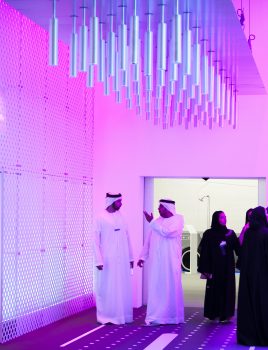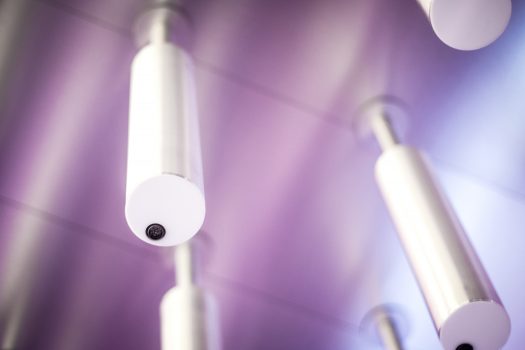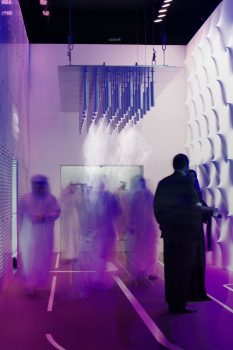Cloud Cast is a system that uses motion tracking and ceiling-mounted misting elements to provide people with a cloud of direct and localized cooling, unveiled at the Museum of Future Government Services during the UAE Government Summit 2015.
Evaporative cooling has been used for centuries in the Arabic peninsula and is still more energy efficient than, say, air conditioning. It is based on generating a cloud of mist that cools the air around it while it evaporates. In traditional systems, however, a lot of energy and water are consumed for cooling outdoor spaces, even when sparsely used. In this project, the misting is focused on people, gaining orders of magnitude in efficiency.
Cloud Cast belongs to a larger array of studies on location-based temperature control infrastructure, exploring how to make public spaces in cities like Dubai more livable and sustainable, by synchronizing human presence with climate control. Dubai has a tropical desert climate: summers are extremely hot and humid, with an average high around 40°C (104°F) and overnight lows around 30°C (86°F). Especially in urban environments, throughout most of the year, the climate discourages people from living and walking outside air conditioned buildings. Cloud Cast aims to address this issue by creating mobile, responsive clouds of fresh air which follow people as they move under a canopy. An array of responsive nebulizers is guided by sophisticated motion sensing, creating a personal climate for each occupant. Individual cooling “clouds” follow people through space, ensuring ubiquitous comfort while improving overall energy efficiency by orders of magnitude.
The Cloud Cast installation at the Museum of Future Government Services recognizes visitors via sensors activating a bi-dimensional array of actuators. More specifically, ultrasonic sensors embedded in the suspended canopy structure detect passersby by interpreting the echoes from high frequency sound waves. The sensors work by measuring the time interval between sending the signal and receiving the echo to determine the distance to the floor, meaning visitors passing between the sensor and the floor will produce an increase or decrease in this time interval, having either absorbed or reflected the sound waves respectively. Data from these sensors is fed to a central control system used to trigger hydro-valves and LED lights in proximity to the detected target. The effect will be that of a responsive mist cloud activated by the visitor and enhanced by backlighting.
We envision the city of the future to be a place designed for people, giving them a chance to actually shape their environment and to fully experience their everyday lives and interactions.




